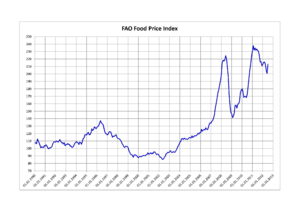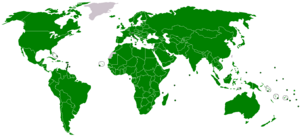Food and Agriculture Organization facts for kids
 |
|
| Abbreviation | FAO |
|---|---|
| Formation | 16 October 1945 |
| Founded at | Quebec City, Canada |
| Type | United Nations specialized agency |
| Legal status | Active |
| Headquarters | Rome, Italy |
|
Director-General
|
Qu Dongyu |
|
Parent organization
|
United Nations Economic and Social Council |
|
Staff (2022)
|
3,202 |
The Food and Agriculture Organization of the United Nations (FAO) is a special part of the United Nations. It works to end hunger and make sure everyone has enough healthy food. Its motto, "Let there be bread," is in Latin. The FAO was started on October 16, 1945.
The FAO has 195 members, including 194 countries and the European Union. Its main office is in Rome, Italy. It also has offices all over the world, working in more than 130 countries. The FAO helps governments and other groups improve farming, forestry, and fishing. It also helps manage land and water resources. The organization does research, offers expert help, runs training programs, and collects information about food production.
A big meeting called the "biennial conference" guides the FAO. Representatives from each member country and the EU attend this meeting every two years. They choose a 49-member council to help lead. The main leader is called the Director-General. Since 2019, Qu Dongyu from China has held this role.
| 100 lire (FAO's celebration.) | |
|---|---|
 |
|
| Obverse: Young woman with braid facing left. Surrounded by Repubblica Italiana [Italian Republic]. | Reverse: Cow nursing calf, face value & date. FAO at bottom and Nutrire il Mondo [Feed the world] at top. |
| Coin minted by Italy in the 1970s to celebrate and promote the Food and Agriculture Organization. | |
Contents
- How the FAO Started
- What the FAO Does
- How the FAO is Organized
- Where the FAO Works
- FAO's Main Goals
- FAO's Programs and Successes
- Food Safety and Standards
- Farming and Plants
- International Plant Protection Convention
- Plant Treaty (ITPGRFA)
- Alliance Against Hunger and Malnutrition
- Integrated Pest Management
- Stopping Animal and Plant Diseases
- Helping Plant Breeding
- Investing in Farming
- Important Agricultural Heritage Systems (GIAHS)
- Commission on Genetic Resources for Food and Agriculture (CGRFA)
- Animal Genetic Resources
- Forests and Trees
- Fishing and Water Animals
- Statistics and Data
- Who Belongs to the FAO
- Making the FAO Better
- See also
How the FAO Started
The idea for a global food and agriculture group began in the late 1800s. A Polish-American farmer named David Lubin was a big supporter of this idea. In 1905, a meeting in Rome, Italy, led to the creation of the International Institute of Agriculture (IIA). The King of Italy, Victor Emmanuel III, helped start it.
The IIA was the first international group to deal with farming issues worldwide. It mainly collected and shared information about agriculture. This included facts about how much food was grown and different plant diseases. One of its big achievements was publishing the first farming census in 1930.
World War II caused the IIA to stop its work. During the war, in 1943, U.S. President Franklin D. Roosevelt called a meeting about food and agriculture. Forty-four governments sent representatives to Hot Springs, Virginia. An economist named Frank L. McDougall had pushed for this meeting since 1935. He wanted a global group to fight hunger.
The meeting ended with a promise to create a permanent food and agriculture organization. This promise came true on October 16, 1945, in Quebec City, Canada. The first FAO meeting happened there too. Sir John Boyd Orr led this meeting. His work to end world hunger and create the FAO helped him win the Nobel Peace Prize in 1949.
After the war, the IIA officially closed in 1948. Its work and offices were then moved to the new FAO in Rome.
What the FAO Does
At first, the FAO helped with farming research and gave expert advice to countries. This helped them grow more food, fish, and trees. In the 1960s, the FAO started focusing on growing special types of grain that produced a lot of food. It also worked to end protein shortages, create jobs in rural areas, and increase farm exports.
In 1961, the FAO realized that natural resources were decreasing. It teamed up with the International Biological Program in 1967 to address this. The FAO also helped the UN General Assembly create the World Food Programme. This is the largest group that helps people who are hungry and works for food security.
In 1968, the FAO started its Money and Medals Programme. It made special collector medals to highlight the FAO's goals. Over a hundred medal designs were made through this program. A medal was even made in 1998 to celebrate its 30th anniversary.
In 1974, after a famine in Africa, the FAO held the first World Food Summit. This meeting was about widespread hunger and not having enough food. The meeting declared that "every man, woman, and child has the right to be free from hunger." It also set a goal to end these problems within ten years. Another summit in 1996 looked at why the goal wasn't met. It then made a new plan to fight hunger into the 21st century.
Every year, the FAO publishes important reports. These reports are about the state of food, farming, forests, fishing, and natural resources around the world.
How the FAO is Organized
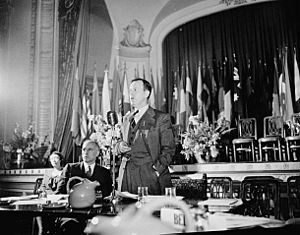
In 1951, the FAO's main office moved from Washington, D.C., USA, to Rome, Italy. The Conference of Member Nations leads the agency. This group meets every two years to check the FAO's work. They also plan the work and budget for the next two years. The conference chooses a council of 49 member states. These states serve for three years at a time. The conference also elects the Director-General, who is the head of the agency.
The FAO has eight main departments. These include groups for farming, Climate, Biodiversity, land and water, money and social development, fishing and Aquaculture, Forestry, and technical help.
Starting in 1994, the FAO made big changes to how it works. It gave more power to its local offices and made its processes simpler. This helped save about US$50 million each year.
How the FAO is Funded
The FAO's main budget comes from its member countries. These payments are decided at the FAO Conference. This money pays for the FAO's main work, like sharing knowledge and giving policy advice. It also covers running the offices and security.
Countries and other partners also give money for specific projects. This money helps governments with special needs or emergencies. For example, it helps with rebuilding after disasters. These extra contributions were expected to be around US$1.6 billion in 2016–2017.
FAO Leaders
Here are the people who have been the main leaders (Directors-General) of the FAO:
- John Boyd Orr, October 1945 – April 1948
- Norris E. Dodd, April 1948 – December 1953
- Philip V. Cardon, January 1954 – April 1956
- Herbert Broadley, (acting) April 1956 – November 1956
- Binay Ranjan Sen, November 1956 – December 1967
- Addeke Hendrik Boerma, January 1968 – December 1975
- Edouard Saouma, January 1976 – December 1993
- Jacques Diouf, January 1994 – December 2011
- José Graziano da Silva, January 2012 – July 2019
- Qu Dongyu, August 2019 – present
Where the FAO Works
FAO Headquarters
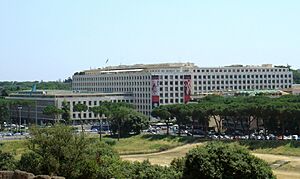
The FAO's main office is in Rome, Italy. It used to be the office for Italian East Africa. A famous part of the building was the Axum Obelisk. This tall stone monument stood in front of the office. It was taken from Ethiopia by Italian troops in 1937. It was returned to Ethiopia on April 18, 2005.
Regional Offices
The FAO has offices that cover large areas of the world:
- Africa: Accra, Ghana
- Asia and the Pacific: Bangkok, Thailand
- Europe and Central Asia: Budapest, Hungary
- Latin America and the Caribbean: Santiago de Chile, Chile
- Near East: Cairo, Egypt
Sub-regional Offices
There are also offices for smaller regions:
- Central Africa: Libreville, Gabon
- Central Asia: Ankara, Turkey
- Eastern Africa: Addis Ababa, Ethiopia
- Mesoamerica: Panama City, Panama
- North Africa: Tunis, Tunisia
- Southern Africa and East Africa: Harare, Zimbabwe
- The Caribbean: Bridgetown, Barbados
- Gulf Cooperation Council States and Yemen: Abu Dhabi, United Arab Emirates
- Pacific Islands: Apia, Samoa
Liaison Offices
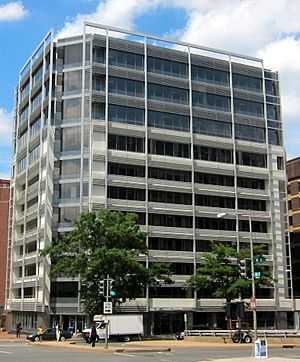
These offices connect the FAO with other important groups:
- North America: Washington, D.C., United States
- Japan: Yokohama
- European Union and Belgium: Brussels
- Russian Federation: Moscow
- United Nations (Geneva): Geneva, Switzerland
- United Nations (New York): New York City, United States
FAO's Main Goals
The FAO has clear goals in its fight against hunger:
- End Hunger and Malnutrition: They work to create policies and agreements that help people get enough food. They also make sure information about hunger is easy to find.
- Make Farming, Forestry, and Fishing Better and Last Longer: They promote ways to grow more food and manage resources without harming the environment.
- Reduce Poverty in Rural Areas: They help poor people in the countryside get the resources and services they need. This includes jobs and social support.
- Create Fair and Good Food Systems: They help build food systems that are safe and work well. This supports small farmers and helps reduce poverty and hunger in rural areas.
- Help People Deal with Disasters: They help countries get ready for natural disasters and other problems. This makes their food and farming systems stronger.
Two important areas, gender equality and good governance, are part of all these goals.
FAO's Programs and Successes
Food Safety and Standards
The FAO and the World Health Organization (WHO) created the Codex Alimentarius Commission in 1961. This group develops food standards and guidelines. Their main goals are to protect people's health, ensure fair trade, and coordinate all food standards work.
World Food Summit
In 1996, the FAO held the World Food Summit. Leaders from 112 countries attended. The summit ended with the Rome Declaration. This set a goal to cut the number of hungry people in half by 2015. Many non-government groups also attended. They wanted governments and the FAO to do more to protect the "Right to Food" for poor people.
TeleFood
In 1997, the FAO started TeleFood. This campaign used concerts, sports events, and other activities to fight hunger. It raised almost US$28 million. This money helps small farmers grow more food for their families and communities. For example, projects have helped families raise pigs in Venezuela. They have also created school gardens in Cape Verde and Mauritania.
FAO Goodwill Ambassadors
The FAO Goodwill Ambassadors Programme began in 1999. It helps raise public awareness about hunger and food security issues worldwide.
Right to Food Guidelines
In 2004, the Right to Food Guidelines were adopted. These guidelines help countries understand how to make sure their citizens have the right to food.
Helping During Food Crises
In 2007, the FAO started an effort to help small farmers. This was in response to rising food prices. The FAO worked with the UN High-Level Task Force on the Global Food Crisis. They created a plan to help. The FAO has done projects in over 25 countries. It also gives advice to governments and supports their efforts to grow more food. For example, it provided funding for seeds in Haiti, which greatly increased food production.
FAO–EU Partnership
In 2009, the FAO and the European Union (EU) agreed on an aid package of €125 million. This money helped small farmers in countries affected by high food prices. The EU's €1 billion Food Facility helped set this up. The FAO received about €200 million for work in 25 countries.
Food Security Programs
The Special Programme for Food Security is a key FAO effort. It aims to cut the number of hungry people in the world in half. This is part of its commitment to the Millennium Development Goals. Through projects in over 100 countries, the program finds real solutions to end hunger and poverty. The FAO wants countries to take ownership of these programs.
Online Campaign Against Hunger
The 1billionhungry project became the EndingHunger campaign in April 2011. The FAO leads this effort with other UN groups. It uses the internet and partnerships to spread its message. In 2010, the 1billionhungry project collected over three million signatures on a global petition to end hunger. This petition was given to world leaders in Rome in November 2010.
The campaign uses social media like Facebook and Twitter. It encourages young people (14-25 years old) to get involved. The yellow whistle is the campaign's symbol. It means "blowing the whistle" on the quiet problem of hunger. Many famous people have supported the campaign. These include former Brazilian President Luiz Inácio Lula da Silva, actress Susan Sarandon, and Olympic legend Carl Lewis.
Farming and Plants
International Plant Protection Convention
The FAO created the International Plant Protection Convention (IPPC) in 1952. This international agreement works to stop the spread of pests and plant diseases. It keeps lists of plant pests and tracks outbreaks. It also helps countries work together. As of July 2018, 183 countries had agreed to this treaty.
Plant Treaty (ITPGRFA)
The FAO is in charge of the International Treaty on Plant Genetic Resources for Food and Agriculture. This is also called the Plant Treaty or Seed Treaty. It started in 2004.
Alliance Against Hunger and Malnutrition
The Alliance Against Hunger and Malnutrition (AAHM) helps countries and groups fight hunger better. It connects local, national, and international organizations that share the goal of ending hunger. The AAHM works to improve food security by sharing resources and knowledge.
This Alliance was started in 2002 after the World Food Summit. Its goal comes from the Millennium Development Goals. It was founded by the FAO, the World Food Programme (WFP), the International Fund for Agricultural Development (IFAD), and Bioversity International.
Integrated Pest Management
In the 1990s, the FAO played a big role in promoting integrated pest management for rice farming in Asia. This taught farmers how to control pests in a smart way. Hundreds of thousands of farmers learned through "Farmer Field Schools". Countries like Australia, the Netherlands, Norway, and Switzerland helped fund these schools.
Stopping Animal and Plant Diseases
In 1994, the FAO set up an "Emergency Prevention System for Transboundary Animal and Plant Pests and Diseases". This system focuses on controlling diseases like rinderpest (a cattle disease), foot-and-mouth disease, and avian flu. It helps governments work together to stop these diseases. The "Global Rinderpest Eradication Programme" has almost wiped out rinderpest in many parts of Asia and Africa. The "Desert Locust Information Service" watches locusts worldwide and tells countries what to expect.
Helping Plant Breeding
The Global Partnership Initiative for Plant Breeding Capacity Building (GIPB) helps countries improve plant breeding. Its goal is to help developing countries grow better crops for food security. This means making sure there are enough skilled plant breeders and experts. Plant breeding helps make crops stronger and more adaptable. This is important for dealing with food crises and growing enough food for everyone.
Investing in Farming
The FAO has an Investment Centre. This center helps developing countries plan good farming projects. It also helps them get money from big organizations like the World Bank.
Important Agricultural Heritage Systems (GIAHS)
The Globally Important Agricultural Heritage Systems (GIAHS) program started in 2002. It aims to find and protect important farming systems around the world. These systems include special ways of farming, unique plants and animals, and traditional knowledge. The GIAHS program recognizes how important family farms are for sustainable farming and rural development.
Commission on Genetic Resources for Food and Agriculture (CGRFA)
The Commission on Genetic Resources for Food and Agriculture started in 1983. It focuses on protecting the variety of living things used for food and farming. Its main goal is to make sure these resources are used wisely and shared fairly for everyone.
Animal Genetic Resources
The FAO has a group that focuses on Animal Genetic Resources for Food and Agriculture. These are animal types used for food and farming. The FAO helps countries follow the Global Plan of Action for Animal Genetic Resources. It supports different ways to protect animal genes, like keeping them in special banks or protecting them in their natural homes.
Forests and Trees
One of the FAO's main goals is to manage the world's forests in a way that lasts. The Forestry Division works to balance the needs of people living near forests with protecting the environment. The FAO is a place where countries can talk about forest policies. It also provides information and expert advice to help countries manage their forests.
The FAO collects information about forests worldwide. It helps countries gather their own forest data. Every five years, the FAO does a "Global Forest Resources Assessment" (FRA). This report gives a full picture of forests around the world. The FRA 2020 is the most recent assessment.
Every two years, the FAO publishes the State of the World's Forests. This report covers current issues facing forests.
Since 1947, the FAO has published the FAO Yearbook of Forest Products. This book has facts about forest products from over 100 countries. It shows how much is produced and traded.
Unasylva is the FAO's journal about forestry. It has been published regularly since 1947. It is the longest-running forestry journal in the world.
The FAO helps sponsor International Day of Forests on March 21 each year. The United Nations General Assembly announced this day in 2012.
Every six years, the FAO and a host country hold the World Forestry Congress. This is a meeting where people share knowledge about how to protect and use the world's forests.
Tree Cities of the World
In October 2018, the FAO and the Arbor Day Foundation started the Tree Cities of the World program. This program celebrates cities and towns that are committed to taking care of their urban forests. By the end of 2019, any city responsible for its trees could apply. On February 4, 2020, 59 cities were named Tree Cities of the World.
Fishing and Water Animals

The FAO Fisheries and Aquaculture Department has a clear goal:
- Vision: To have a world where using fish and water animals wisely helps people, provides food, and reduces poverty.
- Mission: To make global rules stronger and help countries manage their water resources better. They also help build agreement on how to protect and use water animals.
The department works on managing fishing and aquaculture (farming water animals) in a way that lasts.
The FAO Code of Conduct for Responsible Fisheries was put in place in 1995.
Statistics and Data
ESSG stands for the Global Statistics Service. This is a major part of the FAO's Statistics Division. It updates and shares the FAOSTAT report. This report gives free access to data for 245 countries and 35 regions. The data goes from 1961 to the most recent year. You can easily look at and download this information.
The Land and Water Division keeps a database of global water statistics called Aquastat. The Fisheries and Aquaculture Division keeps a database of global fishing and aquaculture statistics called FishStat.
Who Belongs to the FAO
As of May 1, 2020, the FAO has 194 Member Nations, one Member Organization (the European Union), and two Associate Members.
- Afghanistan
- Albania
- Algeria
- Andorra
- Angola
- Antigua and Barbuda
- Argentina
- Armenia
- Australia
- Austria
- Azerbaijan
- Bahamas, The
- Bahrain
- Bangladesh
- Barbados
- Belarus
- Belgium
- Belize
- Benin
- Bhutan
- Bolivia
- Bosnia and Herzegovina
- Botswana
- Brazil
- Brunei
- Bulgaria
- Burkina Faso
- Burundi
- Cambodia
- Cameroon
- Canada
- Cape Verde
- Central African Republic
- Chad
- Chile
- China
- Colombia
- Comoros
- Congo, Democratic Republic of the
- Congo, Republic of the
- Cook Islands
- Costa Rica
- Côte d'Ivoire (Ivory Coast)
- Croatia
- Cuba
- Cyprus
- Czech Republic (Czechia)
- Denmark
- Djibouti
- Dominica
- Dominican Republic
- Ecuador
- Egypt
- El Salvador
- Equatorial Guinea
- Eritrea
- Estonia
- Eswatini (Swaziland)
- Ethiopia
- European Union
- Faroe Islands
- Fiji
- Finland
- France (French Republic)
- Gabon
- Gambia, The
- Georgia
- Germany
- Ghana
- Greece
- Grenada
- Guatemala
- Guinea
- Guinea-Bissau
- Guyana
- Haiti
- Honduras
- Hungary
- Iceland
- India
- Indonesia
- Iran
- Iraq
- Ireland
- Israel
- Italy
- Jamaica
- Japan
- Jordan
- Kazakhstan
- Kenya
- Kiribati
- Korea, Democratic People's Republic of
- Korea, Republic of
- Kuwait
- Kyrgyzstan
- Laos
- Latvia
- Lebanon
- Lesotho
- Liberia
- Libya
- Lithuania
- Luxembourg
- Madagascar
- Malawi
- Malaysia
- Maldives
- Mali
- Malta
- Marshall Islands
- Mauritania
- Mauritius
- Mexico
- Micronesia, Federated States of
- Moldova
- Monaco
- Mongolia
- Montenegro
- Morocco
- Mozambique
- Myanmar (Burma)
- Namibia
- Nauru
- Nepal
- Netherlands
- New Zealand
- Nicaragua
- Niger
- Nigeria
- Niue
- North Macedonia
- Norway
- Oman
- Pakistan
- Palau
- Panama
- Papua New Guinea
- Paraguay
- Peru
- Philippines
- Poland
- Portugal
- Qatar
- Romania
- Russian Federation
- Rwanda
- Saint Kitts and Nevis
- Saint Lucia
- Saint Vincent and the Grenadines
- Samoa
- San Marino
- São Tomé and Príncipe
- Saudi Arabia
- Senegal
- Serbia
- Seychelles
- Sierra Leone
- Singapore
- Slovakia
- Slovenia
- Solomon Islands
- Somalia
- South Africa
- South Sudan
- Spain
- Sri Lanka
- Sudan
- Suriname
- Sweden
- Switzerland
- Syria
- Tajikistan
- Tanzania
- Thailand
- Timor-Leste (East Timor)
- Togo
- Tokelau
- Tonga
- Trinidad and Tobago
- Tunisia
- Turkey
- Turkmenistan
- Tuvalu
- Uganda
- Ukraine
- United Arab Emirates
- United Kingdom
- United States
- Uruguay
- Uzbekistan
- Vanuatu
- Venezuela
- Vietnam
- Yemen
- Zambia
- Zimbabwe
Taiwan (which represented China at the time) left the FAO in 1951. In 1971, the People's Republic of China was recognized as the representative of China by the FAO.
The only UN member state that is not part of the FAO is Liechtenstein.
The two UN observer states, the Holy See (Vatican City) and Palestine, are also not FAO members.
Some countries have special representatives to the FAO. For example, the United States Ambassador to the Food and Agriculture Organization has ambassador rank. This person is also part of the United States Mission to the UN Agencies in Rome.
Making the FAO Better
In November 2007, the FAO Conference agreed to a report that looked at how the organization could improve. They set up a committee to follow up on the report's ideas. This committee was open to all members. It was tasked with reviewing the report and making a plan to put its ideas into action.
A big plan to change the FAO started in 2008. This plan aimed to make the organization more efficient. They changed how the main office was set up. They also gave more power to local offices. This made the FAO faster at responding and saved money. They also made their processes simpler. Better teamwork and stronger partnerships helped too. Upgrading their computer systems also allowed the FAO to respond quickly where help was needed most.
Since the FAO is mainly about knowledge, investing in its staff is very important. They started programs to build skills, rotate employees, and train new young professionals. They also set up ways to check individual performance. An ethics officer and an independent evaluation office were created. These help improve performance and make sure things are done correctly.
In January 2012, the Director-General José Graziano da Silva promised to finish the FAO's reform. He focused on making sure the changes actually helped the organization.
In July 2020, the FAO Council approved new steps proposed by Director-General Qu Dongyu. These steps aimed to modernize the organization. They wanted to make it more flexible and better at working together. This helps the FAO respond to new needs and important issues.
See also
 In Spanish: Organización de las Naciones Unidas para la Alimentación y la Agricultura para niños
In Spanish: Organización de las Naciones Unidas para la Alimentación y la Agricultura para niños
- FAO Country Profiles
- Regional Animal Health Center for North Africa
- World Food Day
- World Summit on Food Security 2009
- World Programme for the Census of Agriculture
- World Vegetable Center




